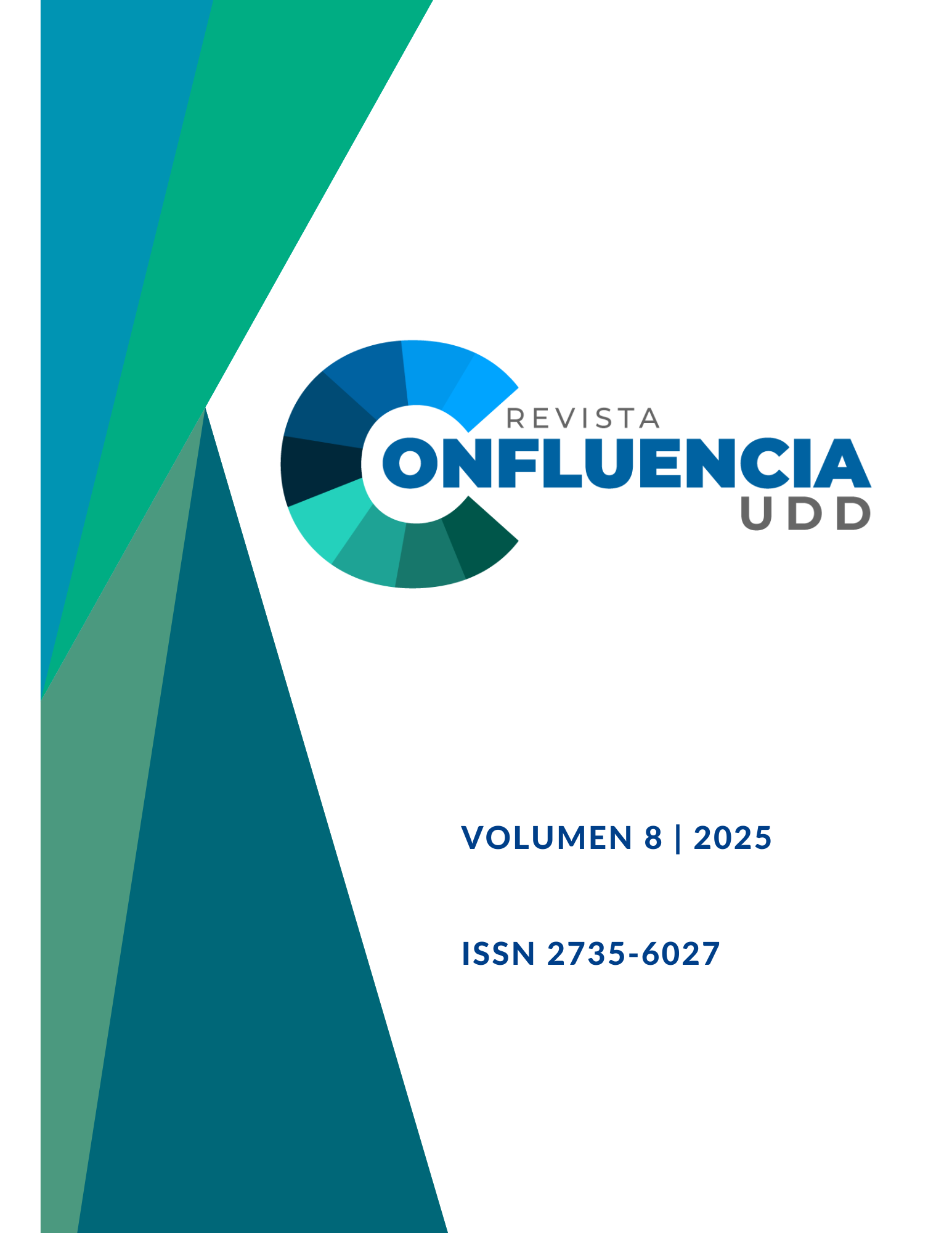Epidemiological update: Mortality rate from subarachnoid hemorrhage during the period 2016 to 2023 in Chile
DOI:
https://doi.org/10.52611/confluencia.2025.1444Keywords:
Subarachnoid Hemorrhage, Neurology, Mortality, Epidemiology, Older adultsAbstract
Introduction: Subarachnoid hemorrhage is a neurological emergency characterized by the extravasation of blood into the subarachnoid space, often caused by the rupture of a cerebral aneurysm or a traumatic brain injury. Its global incidence ranges from 2 to 8 cases per-100.000 inhabitants per year. In Chile, although data are limited, prevalence appears to fall within this range, with a notable increase among young and middle-aged adults. Objective: To describe the mortality rate from subarachnoid hemorrhage between 2016 and 2023 in Chile, identifying the sex, age group, and region with the highest mortality. Methodology: Observational, descriptive, cross-sectional study. Mortality data with subarachnoid hemorrhage (ICD-10: I60) as the underlying cause of death were used, along with population projections based on the 2024 Census. Statistical analyses were conducted. Result: A total of 3.882 deaths due to subarachnoid hemorrhage were recorded. Women died more frequently than men, and the 80+ age group reported the highest number of deaths in both sexes throughout the study period. Discussion: National epidemiology aligns with international trends; there is an increase in subarachnoid hemorrhage -related mortality with advancing age, and it is more common in women. Conclusion: The mortality rate from subarachnoid hemorrhage increased over the years analyzed, which may be explained by a higher burden of comorbidities in older populations. It is essential to improve timely and specialized care to enhance mortality indicators, reduce long-term sequelae, and optimize clinical outcomes for patients.
Downloads
References
Brenes Zumbado MJ, Romero Castillo A, Jiménez Víquez M. Abordaje de hemorragia subaracnoidea. Rev Méd Sinerg [Internet]. 2020 [citado el 3 de julio 2025];5(10):e589. Disponible en: https://doi.org/10.31434/rms.v5i10.589
Riveros C, Quintana A, Martínez M, Miskinich M, Cabañas J, Britez D, Medina K, Montiel D. Frecuencia de complicaciones neurológicas de hemorragia subaracnoidea. Rev Virtual Soc Parag Med Int [Internet]. 2022 [citado el 3 de julio 2025];9(2):113-9. Disponible en: http://dx.doi.org/10.18004/rvspmi/2312-3893/2022.09.02.113
Soto Páramo DG. Actualización en hemorragia subaracnoidea. Med Gen Fam [Internet]. 2023 [citado el 3 de julio 2025];12(4):179-85. Disponible en: http://dx.doi.org/10.24038/mgyf.2023.046
Lara Abril CA, Narváez Rivera SM. Mortalidad por hemorragia subaracnoidea espontánea secundaria a malformaciones vasculares cerebrales. CAMbios Rev Méd [Internet]. 2022 [citado el 3 de julio 2025];21(1):e746. Disponible en: http://dx.doi.org/10.36015/cambios.v21.n1.2022.854
dos Santos M, Praciano M, Moura G, Freitas A, Dutra G, Neres R, et al. Cefaleia e Hemorragia Subaracnóidea: Desafios Diagnósticos, Manejo Clínico e Cirúrgico. JMBR [Internet]. 2024 [citado el 3 de julio 2025];1(5):283-9. Disponible en: https://doi.org/10.70164/jmbr.v1i5.389
Lawton M, Vates E. Subarachonoid Hemorrhage. N Engl J Me [Internet]. 2017 [citado el 3 de julio 2025];377:257-66. Disponible en: http://doi.org/10.1056/NEJMcp1605827
Vázquez-Gómez LA. Comportamiento de la hemorragia subaracnoidea espontánea. Acta Med Cent [Internet]. 2020 [citado el 3 de julio 2025];15(4):542-50. Disponible en: https://www.medigraphic.com/cgi-bin/new/resumenI.cgi?IDARTICULO=111204
Runde D. Calculated decisions: modified Rankin Scale for neurologic disability. Emerg Med Pract [Internet]. 2021 [citado el 15 de julio 2025];23(Suppl 6):CD1-CD3. Disponible en: https://pubmed.ncbi.nlm.nih.gov/36996469/
Papadimitriou-Olivgeris M, Zotou A, Koutsileou K, Aretha D, Boulovana M, Vrettos T, et al. Factores de risco para mortalidade após hemorragia subaracnoidea: estudo observacional retrospectivo. Rev Bras Anestesiol [Internet]. 2019 [citado el 3 de julio 2025].;69(5):448-54. Disponible en: https://doi.org/10.1016/j.bjan.2019.06.004
Thilak S, Brown P, Whitehouse T, Gautam N, Lawrence E, Ahmed Z, et al. Diagnosis and management of subarachnoid haemorrhage. Nat Commun [Internet]. 2024 [citado el 3 de julio 2025];15(1):1850. Disponible en: https://doi.org/10.1038/s41467-024-46015-2
Roa Castillo S, Otto Sanguineti ME, Ascencio Fernández E. An epidemiological characterization of patients with acute stroke in a single Chilean hospital using diagnosis-related group registers. Medwave [Internet]. 2019 [citado el 3 de julio 2025];19(6):e7668. Disponible en: https://europepmc.org/article/med/31348768
Schupper AJ, Hardigan TA, Mehta A, Yim B, Yaeger KA, De Leacy R, et al. Sex and Racial Disparity in Outcome of Aneurysmal Subarachnoid Hemorrhage in the United States: A 20-Year Analysis. Stroke [Internet]. 2023 [citado el 3 de julio 2025];54(5):1347-56. Disponible en: http://dx.doi.org/10.1161/STROKEAHA.122.041488
Ramesh S, Christopher R, Indira Devi B, Bhat D. The vascular protective role of oestradiol: a focus on postmenopausal oestradiol deficiency and aneurysmal subarachnoid haemorrhage. Biol Rev Camb Philos Soc [Internet]. 2019 [citado el 3 de julio 2025];94(6):1897-917. Disponible en: http://dx.doi.org/10.1111/brv.12541
Han Y, Zhang B, Qi X, Yuan G, Li X, Hao G, et al. Comparison of sex differences on outcomes after aneurysmal subarachnoid hemorrhage: a propensity score-matched analysis. BMC Neurol [Internet]. 2024 [citado el 3 de julio de 2025];24(1):153. Disponible en: http://dx.doi.org/10.1186/s12883-024-03659-3
Cai Y, Liu Z, Jia C, Zhao J, Chai S, Li Z, et al. Comparison of Sex Differences in Outcomes of Patients With Aneurysmal Subarachnoid Hemorrhage: A Single-Center Retrospective Study. Front Neurol [Internet]. 2022 [citado el 3 de julio de 2025];13:853513. Disponible en: http://dx.doi.org/10.3389/fneur.2022.853513
Berli S, Barbagallo M, Keller E, Esposito G, Pagnamenta A, Brandi G. Sex-Related Differences in Mortality, Delayed Cerebral Ischemia, and Functional Outcomes in Patients with Aneurysmal Subarachnoid Hemorrhage: A Systematic Review and Meta-Analysis. J Clin Mes [Internet]. 2024 [citado el 3 de julio de 2025];13(10):2781. Disponible en: http://dx.doi.org/10.3390/jcm13102781
Torres Maceo MJ, Pérez Castillo S, Soto González R. Características clinicoepidemiológicas de pacientes ingresados por enfermedad cerebrovascular en una unidad de cuidados intensivos. MEDISAN [Internet]. 2015 [citado el 3 de julio 2025];19(9):1096-102. Disponible en: https://www.medigraphic.com/cgi-bin/new/resumen.cgi?IDARTICULO=61010
Bugazia S, Boshnaf M, Sreenivasan A. 278: Subarachnoid hemorrhage mortality trends in U.S. Patients with circulatory disease (1999-2020). Crit Care Med [Internet]. 2024 [citado el 3 de julio 2025];52(1):S114. Disponible en: http://dx.doi.org/10.1097/01.ccm.0000999300.33430.e9
Yáñez L. Región de Los Lagos [Internet]. .Santiago: Oficina de Estudios y Políticas Agrarias; 2025 [citado el 3 de julio 2025]. Disponible en: https://bibliotecadigital.odepa.gob.cl/bitstream/handle/20.500.12650/72869/Ficha-regional-Los-Lagos.pdf
Rautalin I, Krishnamurthi RV, Anderson CS, Barber PA, Barker-Collo S, Bennett D, et al. Demographic disparities in the incidence and case fatality of subarachnoid haemorrhage: an 18-year nationwide study from New Zealand. Lancet Reg Health West Pac [Internet]. 2024 [citado el 3 de julio 2025];52:101199. Disponible en: http://dx.doi.org/10.1016/j.lanwpc.2024.101199
Consejo para la Transparencia. Directorio de Organismos Regulados. Salud. Dotación a contrata julio 2023: personal con cargo de neurocirujano o neurocirugía [Internet]. Santiago: Portal de Transparencia del Estado de Chile; 2023 [citado el 3 de julio 2025]. Disponible en: https://www.portaltransparencia.cl/PortalPdT/
Ronne Engström E, Baldvinsdóttir B, Aineskog H, Alpkvist P, Enblad P, Eneling J, et al. The impact of previous health on the mortality after aneurysmal subarachnoid hemorrhage: analysis of a prospective Swedish multicenter study. Acta Neurochir (Wien) [Internet]. 2023 [citado el 3 de julio 2025];165(2):443-9. Disponible en: http://dx.doi.org/10.1007/s00701-022-05464-8
Etminan N, Chang HS, Hackenberg K, de Rooij NK, Vergouwen MDI, Rinkel GJE et al. Worldwide Incidence of Aneurysmal Subarachnoid Hemorrhage According to Region, Time Period, Blood Pressure, and Smoking Prevalence in the Population: A Systematic Review and Meta-analysis. JAMA Neurol [Internet]. 2019 [citado el 3 de julio de 2025];76(5):588-97. Disponible en: https://doi.org/10.1001/jamaneurol.2019.0006
Rivero Rodríguez D, Scherle Matamoros C, Fernández Cue L, Miranda Hernández JL, Pernas Sánchez Y, Pérez Nellar J. Factores asociados a una evolución desfavorable en la hemorragia subaracnoidea aneurismática. Serie de 334 pacientes. Neurología [Internet]. 2017 [citado el 15 de julio 2025];32(1):15-21 Disponible en: https://doi.org/10.1016/j.nrl.2014.12.006
Downloads
Published
How to Cite
Issue
Section
License
Copyright (c) 2025 Revista Confluencia

This work is licensed under a Creative Commons Attribution-NonCommercial-NoDerivatives 4.0 International License.








